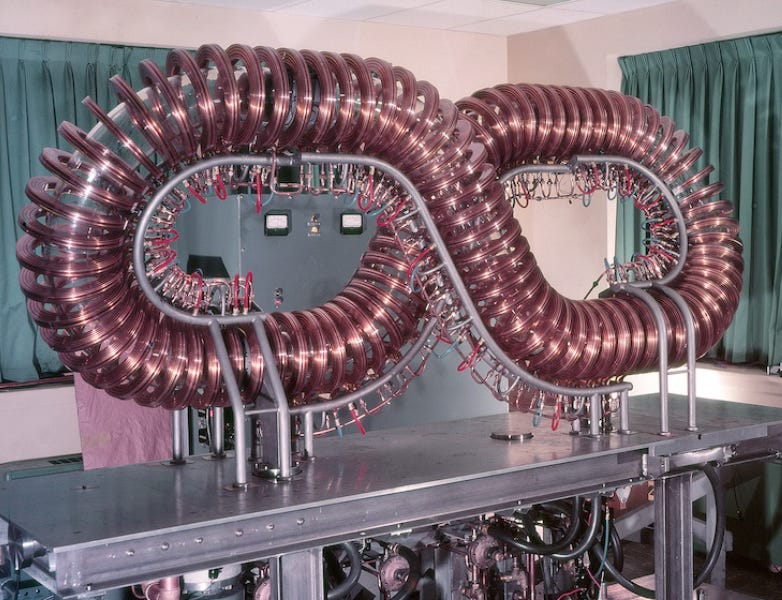Will We Ever Get Fusion Power?

🌈 Abstract
The article discusses the history and current state of nuclear fusion energy research, including the challenges, progress, and future prospects of developing a practical fusion power reactor.
🙋 Q&A
[01] The Appeal and Promise of Fusion Energy
1. What are the key advantages of fusion energy compared to other energy sources?
- Fusion fuel (deuterium) is effectively limitless and found in seawater
- Fusion has a much higher energy density than fossil fuels or nuclear fission
- Fusion can produce carbon-free "baseload" electricity without the intermittency issues of wind or solar
- Fusion waste is far less radioactive than fission waste, and fusion reactors cannot experience a core meltdown
2. Why has achieving practical fusion power proven to be so difficult?
- The extreme conditions required for fusion (temperatures of tens or hundreds of millions of degrees) are extremely difficult to create and maintain
- Plasma behavior is highly complex and turbulent, making it challenging to confine the plasma for long enough to achieve fusion
- Researchers have had to simultaneously solve scientific and engineering problems to make progress on fusion
[02] The Early History of Fusion Research
1. What were some of the early fusion reactor concepts and approaches explored by researchers?
- Gravitational confinement (using gravity to contain the plasma), as in the sun
- Inertial confinement (using explosions or lasers to compress the fuel)
- Magnetic confinement (using magnetic fields to contain the plasma), including pinch machines, stellarators, and tokamaks
2. Why did early fusion research progress so slowly, despite initial optimism?
- Researchers underestimated the complexity of plasma behavior and the difficulty of achieving the necessary conditions for fusion
- Theories about plasma behavior proved inaccurate, and researchers struggled to understand and control plasma instabilities
- Measuring and diagnosing what was happening inside fusion reactors was extremely challenging
[03] The Breakthrough of the Tokamak
1. What was the significance of the Soviet Union's development of the tokamak design?
- Tokamaks were initially seen as a complex and unlikely design, but the Soviets achieved impressive results with their T-3 and TM-3 tokamaks in the late 1960s
- This breakthrough led to a global surge of interest and investment in tokamak fusion research, as countries around the world began building their own tokamaks
2. How did the focus of fusion research shift in the 1970s and 1980s?
- There was a pivot away from theory-driven research towards more empirical, "build it and see" engineering-focused approaches
- The goal shifted towards achieving "breakeven" - producing more fusion power than the input power required to sustain the reaction
- Large tokamak experiments like TFTR, JET, and JT-60 were built, but none were able to achieve breakeven by the 1980s
[04] Setbacks and Stagnation in the 1980s and 1990s
1. What factors led to declining fusion research funding and program cancellations in the U.S. in the 1980s and 1990s?
- Fusion had made slower progress than initially expected, with no working power reactor in sight after decades of research
- Declining energy prices and concerns about the cost-competitiveness of fusion reduced the perceived urgency for the technology
- The Reagan administration shifted away from government-led development of new energy technologies
2. What were the key developments in fusion research during this period of stagnation?
- Researchers continued to make incremental advances, such as discovering the "H-mode" and "VH-mode" plasma confinement regimes
- The ITER international collaboration was formed in the 1980s, aiming to build a large tokamak to study burning plasmas
- Inertial confinement fusion research continued, leading to the construction of the National Ignition Facility (NIF)
[05] The Recent Rise of Private Fusion Companies
1. What factors have enabled the recent surge of private investment and activity in fusion energy?
- Steady scientific and technological advances, such as improved plasma modeling and control, high-temperature superconductors, and more powerful lasers
- The success of Commonwealth Fusion's large funding round in 2021 created a "bandwagon effect" that attracted more investors to the fusion space
- Private companies are pursuing a variety of innovative approaches aimed at building smaller, cheaper fusion reactors
2. How do the prospects and challenges of private fusion companies compare to previous government-led fusion efforts?
- Private companies may be able to move faster and be more nimble than large government-funded programs
- But they still face the fundamental scientific and engineering challenges that have slowed progress for decades
- It remains uncertain whether any private fusion approach can produce a practical, cost-competitive power reactor in the near future